The Appeal of Opaque Chiffon Hijabs: Style and Significance
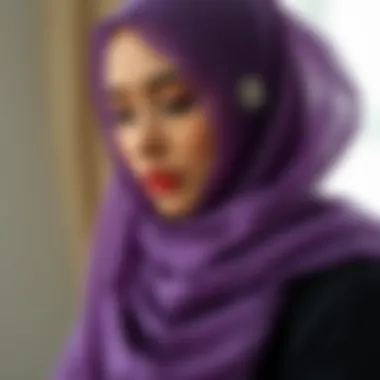
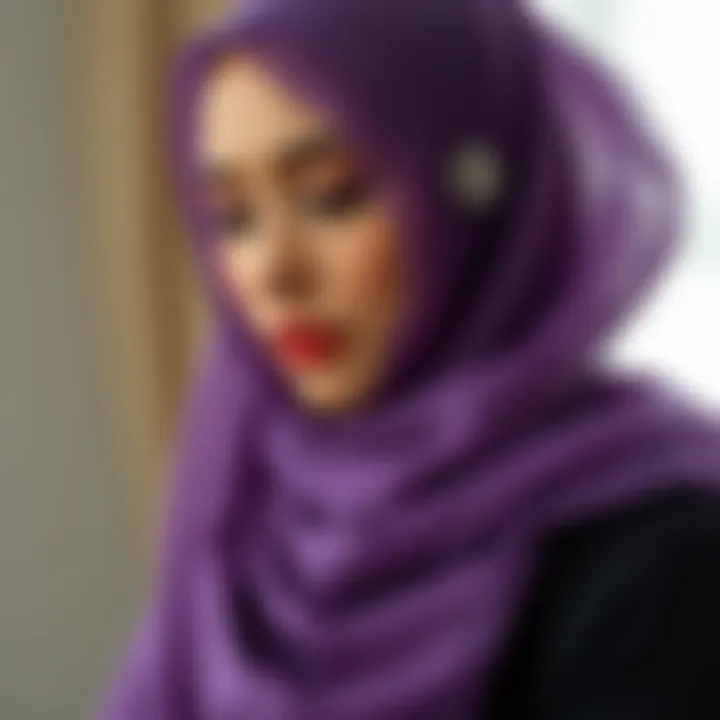
Intro
Opaque chiffon hijabs have piqued the interest of many fashion enthusiasts, acting as a bridge between ancient customs and contemporary style. These hijabs offer an intriguing combination of elegance and practicality. While they embody cultural significance, they are also a style statement for many women worldwide. This article aims to delve into the unique composition of opaque chiffon, its relevance in current fashion, and essential styling tips to elevate your wardrobe.
The choice of fabric has a huge impact on the overall aesthetic of any outfit. Opaque chiffon is particularly appealing because it provides both comfort and coverage. It doesn't cling too tightly, allowing for movement without sacrificing modesty. Understanding the nuances of this fabric helps in selecting the ideal piece, whether it’s for everyday wear or a special occasion. Moreover, the significance of hijabs in modern fashion cannot be overstated, as they reflect personal identity and cultural values.
As trends continue to evolve, opaque chiffon hijabs are gaining traction as versatile accessories. From casual outings to formal events, they seamlessly blend into varying contexts. This narrative will take you through emerging styles, timeless pieces, and some practical tips for maintaining the beauty of this exquisite fabric.
Understanding Opaque Chiffon
Opaque chiffon hijabs hold a unique place within the realms of fashion and cultural identity. Many opt for them not only for their aesthetic appeal but also for their practicality. Understanding opaque chiffon presents several benefits worth exploring. Here, fabric composition plays a crucial role, as does the intrinsic qualities that elevate this material in the fashion world.
Material Composition
Fiber Origins
The origins of the fibers used in opaque chiffon can significantly influence its overall appeal. Primarily composed of polyester or silk, these fabrics are chosen for their rich textures and innate luster. Polyester is durable yet tends to be more budget-friendly, while silk offers an unmatched elegance.
The key characteristic of polyester fibers is their resilience. This factor alone often makes them a preferred choice for those who desire longevity in their hijab collection. A unique feature of these fibers is their ability to maintain their shape even after multiple washes, which is a significant advantage in busy lifestyles. However, it's essential to consider that silk, being natural, can require more delicate handling to preserve its integrity over time.
Weight and Texture
When looking at opaque chiffon, its weight and texture become paramount. Unlike heavier fabrics, opaque chiffon is featherlight, making it incredibly comfortable for all-day wear, yet still providing sufficient coverage. This lightweight nature allows for easy styling and wrapping, catering to diverse layering needs.
One might say that the texture of opaque chiffon dances between soft and slightly crinkled, which offers character to the fabric while ensuring it drapes nicely around the face and shoulders. However, while lightweight, this fabric can sometimes struggle with wind, a point of consideration for those who live in breezy areas.
Breathability Features
Breathability is another hallmark of opaque chiffon. The way the fabric is woven allows air to circulate, which is particularly beneficial in climates that can get quite warm. This quality makes it an appealing choice for those who wish to stay cool and comfortable without sacrificing style.
Typically, opaque chiffon manages to achieve this breathability without compromising its opacity—a rare feat in the world of fabrics. The downside, however, can be that during particularly humid days, even the most breathable of fabrics may still cling, which might call for more mindful styling choices.
Characteristics of Opaque Chiffon
Lightweight Yet Opaque
The dual nature of being both lightweight yet opaque is a defining characteristic of opaque chiffon hijabs, offering a distinct advantage. This unique combination allows wearers to enjoy the easiness of lightweight fabric while ensuring coverage is adequately maintained. This aspect attracts those who prefer a more modest style without the bulk that heavier layers can bring.
Moreover, the fabric's opacity contributes to versatility; it can be dressed up or down, making it suitable for various occasions, from casual meet-ups to more formal settings. A downside could be that extreme weightlessness might mean less structure, making certain styles a touch more challenging for intricate wraps.
Fall and Drape
The way opaque chiffon falls and drapes plays a crucial role in how the garment flows on the body. The fabric’s fluidity allows it to cascade beautifully, creating a soft silhouette that can enhance the wearer’s shape without clinging too tightly. This fall is particularly appealing in traditional dress, where elegance is key.
What sets this characteristic apart is how it can elevate any outfit without overwhelming it—an essential aspect for those looking to achieve a polished look. But, this delicate drape might not hold up under heavy embellishments or accessories, so careful styling is essential.
Color Retention
When it comes to retaining color, opaque chiffon truly shines. The dyes used for this type of fabric are known for their longevity, meaning your chosen shade will stand the test of time without fading quickly. This attribute is particularly important for individuals who invest in their wardrobes thoughtfully and wish to enjoy their favorite pieces for many seasons.
In addition, the range of vibrant colors available ensures that there’s a shade to match just about any outfit or occasion. Still, maintaining this vibrant hue can be somewhat dependent on care practices, so proper washing and storing are vital to ensure your hijab remains splendid.
"Ultimately, opaque chiffon is not just a fabric; it's a blend of culture, function, and fashion that resonates with many."
Cultural Significance of Hijabs
The hijab is often more than just a piece of fabric; it carries profound cultural significance that transcends mere fashion. The cultural significance of hijabs lies in their embodiment of identity, beliefs, and traditions that resonate deeply within various communities. These headscarves symbolize modesty and spirituality while also serving as a canvas for personal expression and style. The rich layers of meaning attached to hijabs invite us to explore the diverse narratives woven into their history and contemporary usage.
Historical Context
Evolution of Hijabs
The evolution of hijabs is a testament to the adaptability of cultural practices over time. Initially, head coverings served practical purposes, such as protection from the elements. However, as societies evolved, the significance of hijabs transformed. They began to represent social status, regional identity, and, eventually, religious affiliations. This layer of historical context is crucial for understanding why hijabs are not just accessories; they are reflections of a journey through time.
For instance, in many Middle Eastern cultures, the hijab has transitioned from a symbol of modesty to a statement of resilience. Women might use hijabs as an assertion of identity in contemporary society, navigating complex dynamics that challenge traditional norms.
Fashion Across Cultures
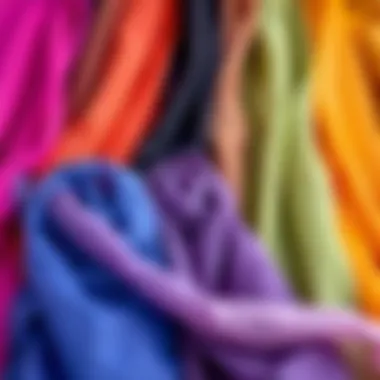
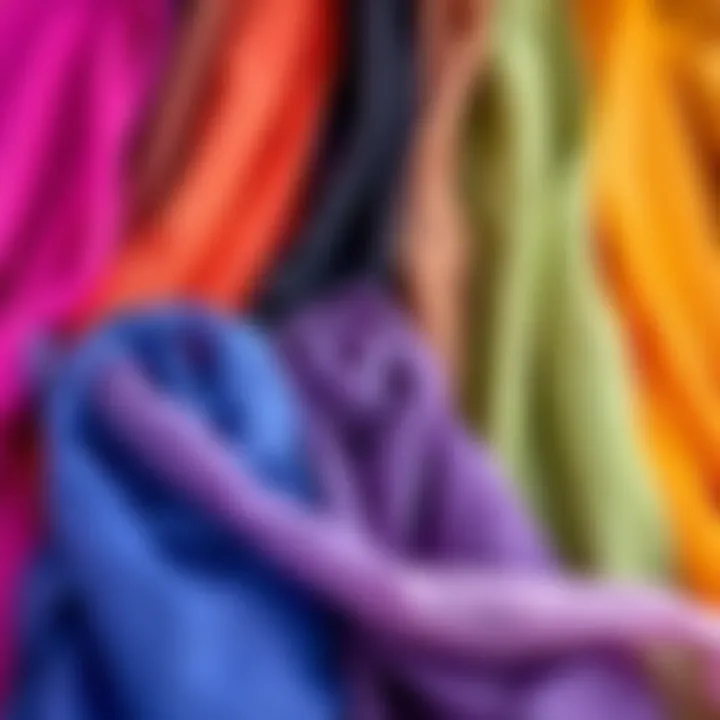
Fashion plays an integral role in how hijabs are perceived globally. The fashion across cultures surrounding hijabs emphasizes how style can act as a unifying force while still respecting underlying beliefs. Styles vary significantly from region to region; for instance, in Turkey, hijabs may be styled with elegant draping, while in South Asia, the emphasis might be on vibrant patterns and prints.
This diversity in design connects cultures and offers a palette of expression for those who wear them. It promotes the idea that hijabs are versatile pieces, suitable for various occasions ranging from daily wear to grand celebrations.
Symbolic Meaning in Various Societies
Symbolic meaning varies widely depending on social context. Within Western societies, hijabs can sometimes be viewed through a lens of misunderstanding, often associated with oppression. Conversely, for many women in Muslim cultures, wearing a hijab is a powerful act of autonomy and intention—a conscious choice that speaks to personal faith and cultural identity.
Understanding these perspectives is essential for fostering dialogue that bridges gaps in perception. Knowing how different societies interpret the hijab can help in promoting cultural awareness and ultimately enrich our appreciation of this significant garment.
Modern Interpretations
Blending Tradition with Modernity
The act of blending tradition with modernity has led to fascinating innovations in hijab styling. Today, designers and wearers alike explore ways to incorporate contemporary fashion trends with traditional values, creating a unique sartorial blend.
This merging often results in designs that are stylish yet respectful, suitable for both formal settings and daily wear. The push towards modern interpretations encourages the idea that hijabs can be part of not just religious identity but also fashion statements, appealing to younger generations seeking to express themselves.
Influence of Social Media
The influence of social media cannot be understated in the context of hijabs. Platforms like Instagram and Pinterest have become hubs for showcasing hijab styles, allowing women from around the world to share their personal interpretations of modest fashion. Social media fosters communities that celebrate diversity, empowering wearers to connect through shared experiences and aesthetics.
This phenomenon bolsters the visibility of hijabs as a global fashion trend, rather than a niche style. It reflects changes within society where modesty and self-expression can coexist harmoniously.
The Role of Fashion Designers
Finally, the role of fashion designers has been pivotal in shaping the narrative around hijabs. Designers like Hana Tajima, for example, are at the forefront of this movement, creating collections that specifically cater to the needs of hijab-wearing women while incorporating current fashion trends.
These designers are instrumental in challenging stereotypes and reimagining the hijab in modern fashion, giving it a place on international runways. Their work highlights the artistry involved in hijab styling—making it a significant part of the fashion discourse.
Culmination
The cultural significance of hijabs transcends basic aesthetics; they encapsulate a spectrum of meanings that reflect personal beliefs, societal roles, and artistic expression. As we dive deeper into the various aspects outlined, it becomes clear that hijabs are much more than fabric; they are vital to understanding cultural identity in a rapidly changing world.
Styling with Opaque Chiffon Hijabs
In the world of fashion, styling with opaque chiffon hijabs opens a gateway to endless creative expressions while embodying both style and cultural significance. Opaque chiffon not only serves as a beautiful addition to an outfit but also as a canvas for self-expression. This section will explore the various dimensions of everyday and special occasion styling, leading to a more profound appreciation of how hijabs can complement diverse wardrobes.
Everyday Wear
Casual Outfits
When it comes to casual outfits, opaque chiffon hijabs effortlessly bridge the gap between comfort and style. These hijabs are typically lightweight, making them a popular choice for everyday wear. One key characteristic that stands out is their versatility; they can be paired with a simple t-shirt, jeans, or even a comfortable maxi dress without creating an overly fussy look.
The unique feature of casual outfits with opaque chiffon lies in their ability to elevate simple attire. Instead of just throwing on a scarf that serves purely functional needs, opting for a chiffon hijab adds a touch of elegance. Often, the subtle sheen of the fabric can transform a mundane look into something polished, allowing for both comfort and flair. However, a downside could be that certain casual styles may require careful draping to ensure that they do not overshadow the outfit, potentially creating a mismatch.
Work Attire
Moving from casual to professional, opaque chiffon hijabs have carved a niche in work attire as well. The key aspect here is their ability to offer sophistication while being office-friendly. Tailored looks combined with these hijabs speak volumes about a person’s attention to detail. Pairing an opaque chiffon hijab with a blazer and tailored trousers can create a crisp, put-together appearance.
In work settings, the unique feature of opaque chiffon is its smooth finish, which complements business wear without being overbearing. This gives a sense of professionalism, appealing to a fashion-forward mindset while also adhering to workplace norms. But on the flip side, choosing the wrong color or style might lead to a stifled look, which can detract from one's overall confidence at work.
Weekend Looks
The weekend naturally invites more comfortable yet stylish choices, and opaque chiffon hijabs can fit right into this aesthetic. Casual chic is the hallmark of weekend looks, allowing for more creative freedom. The key characteristic of weekend wear is its laid-back nature alongside an ability to remain stylish.
One distinct feature of this style is the mix-and-match potential of colors and patterns allowed by opaque chiffon, offering a playfulness unique to leisurely settings. Pairing such hijabs with flowy skirts or relaxed trousers can embody a carefree spirit. However, one needs to be cautious; since the fabric can appear too light in some combinations, it may require thoughtful coordination to avoid looking frumpy or out of place.
Special Occasions
Weddings and Celebrations
Opaque chiffon hijabs have become a staple at weddings and celebrations, where they bring grace to festive attire. A notable aspect of these hijabs in such contexts is their sheer elegance, complementing intricate outfits with ease. Whether draped elegantly over a gown or styled in an artistic manner, they encompass the spirit of celebration.
The unique feature of wearing opaque chiffon for weddings is its flowing quality, enhancing the movement of the outfit. For instance, a hijab adorned with delicate embellishments can tie an entire wedding outfit together beautifully. At the same time, one must consider that the wrong choice of color or design could potentially clash with the vibrant thematic palettes commonly found at such events.
Formal Events
In formal settings, styling with opaque chiffon hijabs can elevate one's look, promoting sophistication and class. Here, the key characteristic is how well they adapt to more structured ensembles such as evening gowns and cocktail dresses. The versatility of chokers and statement jewelry pieces can also harmonize wonderfully with hijabs, adding an impressive finish.
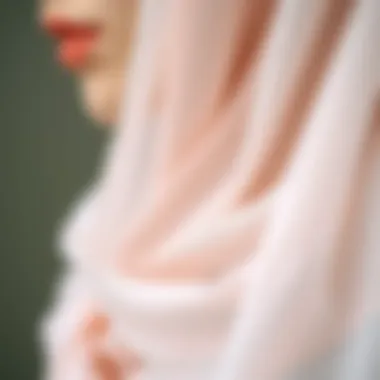
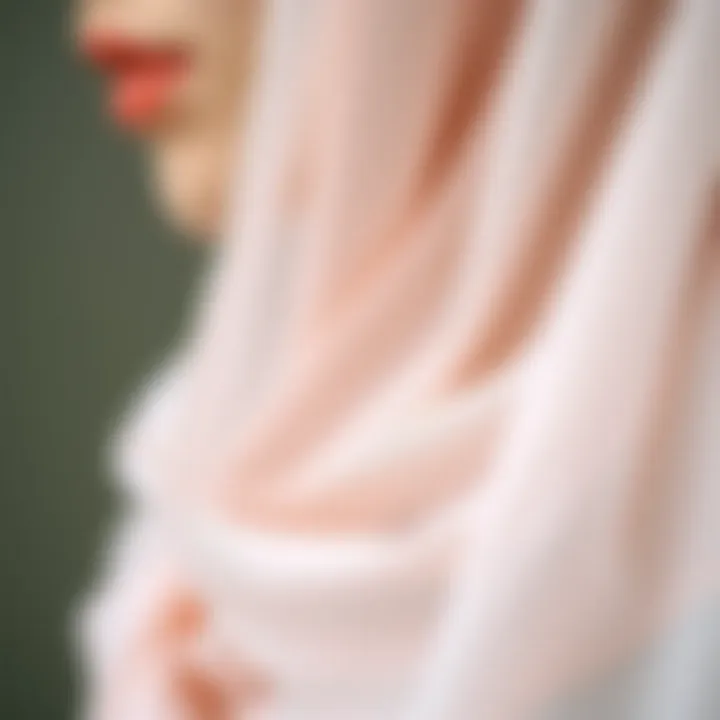
The unique feature of using opaque chiffon for formal events is its luxurious touch, which can make even the simplest outfit appear extravagant. However, this luxurious appearance demands careful attention to detail. A poorly chosen hijab that is not aligned with the formal dress code might detract from the overall elegance expected at these gatherings.
Seasonal Festivities
During seasonal festivities, opaque chiffon hijabs allow an opportunity to embrace colorful palettes and festive vibes. The key aspect of these hijabs for such occasions lies in the ability to incorporate festive colors and patterns suitable for celebrations like Eid or Christmas.
A notable feature of seasonal looks with opaque chiffon hijabs is the ability to mix textures and styles, enabling the creation of visually intriguing outfits. These choices can reflect the individual's personality while also conveying cultural adherence. However, it is essential to avoid looking overly extravagant, as that may dilute the sincerity of the festive engagement.
Keeping an eye on seasonal trends and color palettes can enhance the overall appeal of opaque chiffon hijabs, allowing wearers to celebrate their cultural heritage with flair.
Overall, mastering the art of styling opaque chiffon hijabs can not only enhance personal style but also highlight the cultural richness and adaptability of such garments.
Why Choose Opaque Chiffon?
When considering hijabs, opaque chiffon stands out not merely for its aesthetic appeal but also for the practical benefits that accompany its use. The allure of opaque chiffon hijabs lies in a unique combination of versatility, personal expression, and functional attributes. This section delves into why these garments are worth choosing and how they resonate with the varied needs and tastes of modern individuals.
Versatility in Wear
Layering Options
Layering remains a key strategy in fashion, and with opaque chiffon hijabs, this principle gets an exciting twist. The delicate fabric allows for multiple approaches to style layering. You might think about pairing an opaque chiffon hijab with a light cardigan or a long coat, creating a seamless blend that exudes elegance.
One standout aspect of layering with this material is its lightweight nature; it doesn’t add bulk, making it easy to wear over different outfits. This characteristic has made opaque chiffon a beloved option, particularly during transitional weather when temperatures can fluctuate. However, the layering advantage can also be seen as a double-edged sword. While it offers flexibility, some might find that intricate layers can complicate a look—especially if one is not careful with color coordination or patterns.
Seasonal Adaptability
Opaque chiffon hijabs shine brightly through the seasons. Unlike thicker fabrics, chiffon is breathable, making it comfortable during warmer months while still providing an adequate layer of warmth in cooler temperatures. The fabric’s adaptability offers a chic response to changing climates; it allows the wearer to transition from light summer wear to cozy winter layers without sacrificing style.
The key feature here is indeed the balance between comfort and functionality. A well-chosen opaque chiffon hijab can carry one through a sun-drenched day and then transition gracefully to an evening event, responsive to both comfort and aesthetic desires. That said, when summer heat peaks, there might be a concern about excessive layering which could lead to overheating.
Complementing Diverse Outfits
Another reason to favor opaque chiffon hijabs is the sheer adaptability of the fabric to various outfits. Whether dressing casually or opting for a more formal ensemble, an opaque chiffon hijab can elevate the entire look. Its smooth, flowing nature allows it to drape beautifully, complementing everything from structured blazers to breezy dresses.
The flexibility of pairing with multiple styles is a delightful feature. With opaque chiffon, a mere switch from a simple white shirt to a patterned maxi dress can yield a fresh, stylish appearance. On the flip side, wearers must occasionally grapple with achieving that desired harmony, especially when mixing patterns or colors. Selecting the right opaque chiffon can mean the difference between harmony and chaos in one’s attire.
Personal Expression
Color Choices
Diving into color choices, opaque chiffon hijabs offer a spectrum of options, allowing wearers to express their individuality. The richness and vibrancy of colors available speak to a deep emotional connection people have with their attire. A bold red? Perfect for a statement; soft pastel? Just right for a gentle touch.
One remarkable aspect of color choice is the emotional weight each hue carries. Whether it’s the passion evoked by deeper tones or the calmness offered by lighter shades, hijabs can become a canvas for feelings. However, with such diverse options, wearers may sometimes feel overwhelmed by choices, which can lead to hesitation.
Pattern Variations
Pattern variations in opaque chiffon hijabs add another layer of appeal. From floral designs to geometric patterns, the possibilities are practically endless. This feature caters to the whims of the fashion-savvy crowd, enabling styling that ranges from chic to avant-garde.
Patterns can act as a conversation starter or a bold statement, inviting curiosity and compliment. However, it’s essential to approach patterns thoughtfully, as clashing styles can lead to visual chaos. Those who master the art of matching are likely to reap the rewards, while dissonance might discourage some.
Accessorizing
Accessorizing with opaque chiffon hijabs allows for an exploration of personal style that transcends trends. A well-placed brooch, a striking pair of earrings, or a colorful belt can transform the look entirely. It injects individuality into what might otherwise be a standard outfit, making it uniquely yours.
A classic feature of accessorizing is that it opens doors to creativity, allowing individuals to play with textures and colors. However, too many accessories or an ill-suited piece could detract rather than enhance; thus, finding the right balance is crucial for that polished look.
Choosing opaque chiffon hijabs goes beyond fabric and design; it’s about embracing versatility, style, and individuality. With these elements in mind, the hijab becomes not just a simple garment, but a significant part of every woman’s wardrobe.
Caring for Opaque Chiffon Hijabs
Taking care of opaque chiffon hijabs is essential for maintaining their beauty and longevity. These delicate pieces of fabric are not just fashion statements; they are also an investment in your wardrobe. Proper care ensures that your hijabs maintain their color, texture, and overall appeal. Plus, knowing the right techniques keeps them looking fresh and fashionable for countless wears.
Washing Techniques
Hand Washing vs. Machine Washing
When it comes to cleaning your opaque chiffon hijabs, hand washing is often the best route. This method is gentle and minimizes the risk of snagging or damaging the fabric. By soaking the hijab in lukewarm water mixed with a mild detergent, you allow the fabric to relax and release dirt without harsh agitation. In contrast, machine washing, while convenient, often exposes the hijab to friction that can unravel threads or change its texture over time.
Understanding this difference helps you keep your hijabs in tip-top shape without compromising on quality. If convenience rules your day, use a mesh laundry bag and a gentle cycle, but embrace hand washing for that delicate touch.
Recommended Detergents
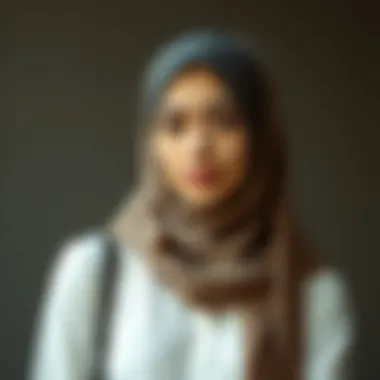
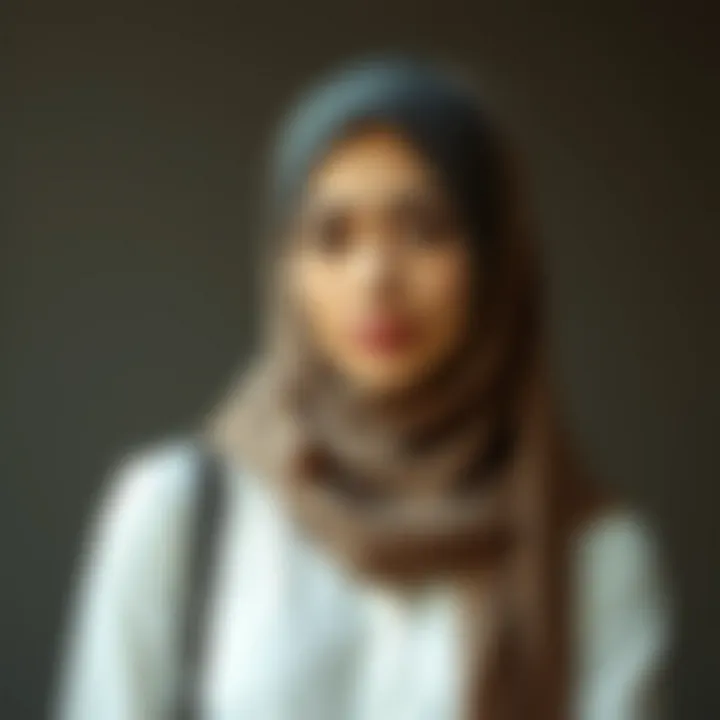
Choosing the right detergent is crucial for preserving the quality of chiffon fabric. Opt for a mild detergent specifically designed for delicate fabrics. These detergents are formulated to clean effectively without stripping away the fabric's color or softness. Avoid bleaches or strong chemicals, as they can cause fading or wear. This careful consideration ensures your hijab stays vibrant and untarnished, giving you even more reasons to love wearing it.
Drying Methods
After washing, how you dry your hijab matters just as much as washing it. Air drying is the gold standard here—simply lay the hijab flat on a clean towel to absorb excess water and then hang it up away from direct sunlight. Sun exposure can fade vibrant colors and weaken fibers. If you’re in a rush, avoid wringing it out or using a dryer at all costs; both can lead to fabric distortion and loss of drape. Choosing to air dry keeps the fabric intact while maintaining its original look.
Storage Strategies
Preventing Creases
Storing your opaque chiffon hijab without creases can be tricky. The key characteristic to focus on is how you fold them. Rather than crumpling or folding them haphazardly, consider rolling them gently. This method not only saves space but also preserves the fabric's smooth surface. Traditional folding leads to unwanted creases, which can be hard to remove without further washing. By rolling, you maintain the quality of the fabric while ensuring it stays ready for your next outing.
Choosing Storage Location
Another important factor is where you choose to store your hijabs. A dark, cool place is ideal to prevent fading from light exposure. If you can, opt for a designated drawer or a shelf, avoiding cramped areas that can lead to crushing or creasing. Having a proper storage strategy not only extends the life of your hijab but also helps you keep track of your collection. It's all about being organized—your style deserves it.
Using Garment Bags
Investing in breathable garment bags can go a long way in protecting your opaque chiffon hijabs. These bags keep dust and dirt at bay while also allowing air circulation, preventing any musty odors. The benefit of using them is twofold: they offer protection from potential snags and keep your hijabs neatly arranged. Make it a habit to place your favorites in a bag, and you'll see how long they last and how lovely they remain.
Proper care of your opaque chiffon hijabs doesn’t just maintain their beauty; it adds value to your fashion collection.
With these care techniques at your fingertips, you’re not just wearing a hijab; you’re embodying a style that respects tradition and embraces modernity.
Selecting the Right Opaque Chiffon Hijab
Choosing an opaque chiffon hijab is not merely a transaction; it’s a selection process that intertwines personal style, cultural significance, and functional needs. The right choice can complete an outfit while offering comfort and confidence. So, how do you sift through myriad options to find that perfect piece? Let’s break it down into key components that will sharpen your understanding and help guide your decision-making.
Understanding Different Styles
Square vs. Rectangular Forms
When it comes to hijab styles, the debate between square and rectangular forms is often a hot topic. Square hijabs are typically easier to tie, creating elegant wraps that sit snugly around the head. This makes them a go-to for casual outings or formal events alike, allowing for quick styling without a fuss. On the other hand, rectangular hijabs offer longer coverage and versatility in styling. You can drape them in various ways, from classic wraps to more modern looks, adapting to your outfit of the day. Look at the unique feature of the rectangular form — its length allows for more ways to wear it, making it favorable for layered styling. However, it can require a bit more practice to master the ties than the square cut, especially for those new to hijab fashion.
Different Lengths
Length can dramatically impact how a hijab looks and feels. Longer hijabs can be comfortably styled in more elaborate ways, flowing neatly down the shoulders or achieving a dramatic drape. Conversely, shorter hijabs tend to be more straightforward in style, and they’re lightweight for those sticky, humid days. Both options come with their perks. A longer hijab can provide more coverage and protection from the elements, making it a practical choice for colder climates or outdoor events. A shorter scarf, on the flip side, can lend itself beautifully to light, casual wear.
Choosing the Right Size
Size is paramount when selecting the right opaque chiffon hijab. The correct dimensions ensure comfort and aesthetic appeal. It’s essential to consider both your head size and your styling preferences before making your choice. A hijab that's too large might feel cumbersome and shift around, and one that’s too small could be uncomfortably tight or limit your styling options. It’s beneficial to try on different sizes before committing to a purchase to grasp how well it complements your individual features and personal style.
Finding Quality Products
Identifying Quality Brands
Not all brands produce hijabs that meet the standards of quality and durability. Finding reputable brands is crucial as they often use superior materials, ensuring longevity and comfort in wear. Keywords to look for include eco-friendly fabrics or ethical production practices, which indicate a brand’s commitment to sustainability. Reputable brands often provide detailed descriptions of their products, enhancing the shopping experience and guiding customers on what to expect.
Reading Customer Reviews
Words from fellow customers can enlighten a potential buyer about a product’s real-world performance. Customer reviews provide insight into everything from product quality to the sizing of hijabs. Positive feedback can affirm a brand's reputation and influence your choice. However, be wary of reviews that seem overly promotional; balance is key. Some critics may provide valuable information on how fabric responds after washing or under different environmental conditions.
Exploring Fabric Samples
If it’s within your means, requesting fabric samples can pave the way to a more informed decision. Experiencing the actual texture in your hands enables you to assess softness, weight, and quality firsthand. By comparing a range of samples, an individual can decide which ones will suit their skin sensitivities and styling needs best. Keep in mind; some companies do offer this service, and it’s a small investment for peace of mind regarding your sartorial choices.
Pro Tip: Before purchasing, check return policies. This way, should the hijab not meet your expectations in quality or style, you can easily exchange it.
In summary, selecting the right opaque chiffon hijab encompasses understanding different styles, lengths, and sizes, alongside finding reputable brands and informative customer feedback. Equip yourself with this knowledge before diving into the fabulous world of hijabs, and you will wear your chosen piece with pride.
End
The conclusion of this article serves to encapsulate the essence of opaque chiffon hijabs, tying together the various threads we've examined throughout. The discussion highlights the intricate relationship between fashion, cultural identity, and personal expression through these garments. Opaque chiffon hijabs are not merely articles of clothing but represent a blend of practicality and elegance that resonates with many individuals.
Embracing Fashion with Cultural Sensitivity
In today’s fast-paced world, it’s vital to acknowledge the cultural fabric woven into the practice of wearing hijabs. Each hijab, especially those crafted from opaque chiffon, tells a profound story that echoes across generations. Fashion influences are rampant, yet it’s essential to approach this topic with respect for the traditions and customs that shape these styles.
From tea time in Turkey to bustling streets in Jeddah, the hijab finds its place in diverse environments, acting as a bridge connecting the past with modernity. When choosing opaque chiffon hijabs, one should embrace this cultural depth, ensuring that one’s choices reflect an understanding of the cultural significance behind the fabric and design.
- Select with Intent: When wearing a hijab, consider not just the style but also the values it represents. Each pattern, each color can signify something deeper—why not choose one that resonates with your own story?
- Accessorize Mindfully: The addition of accessories should harmonize with the overall aesthetic and cultural context of the hijab. This can enhance the attire while remaining respectful of its traditions.
- Educate Yourself and Others: When discussing hijabs in broader circles, share insights about their significance and unwavering beauty. It helps foster appreciation and understanding, enriching conversations about fashion.
"Fashion should not only empower one’s individuality but also reflect respect towards the cultures it draws inspiration from."
As we move forward, it’s imperative to blend modern trends with the rich cultural significances embodied in opaque chiffon hijabs. This respectful integration will not just enhance personal style but also contribute to a greater appreciation for the tapestry of cultural identities in our global society.







